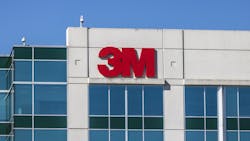3M announces $10.3B agreement for PFAS remediation
Water systems suing 3M have reached a $10.3 billion settlement over per- and polyfluoroalkyl substances pollution in U.S. drinking water systems.
In March of this year, the U.S. EPA announced Maximum Contaminant Levels for six PFAS chemicals. Perfluorooctanoic acid (PFOA), perfluorooctane sulfonic acid (PFOS) are proposed at 4 parts per trillion and the remaining four — perfluorononanoic acid (PFNA), perfluorohexane sulfonic acid (PFHxS), perfluorobutane sulfonic acid (PFBS), and hexafluoropropylene oxide dimer acid (HFPO-DA, also known as GenX Chemicals) — are covered in the Hazard Index, which is a sum of fractions related to concentration levels for each of the four chemicals in the index. The cost for advanced treatment has been a point of many public comments on this proposal.
In a press release June 22, 3M announced the PFAS remediation effort for public water suppliers that would provide funds to PWS for PFAS treatment “without the need for further litigation” while also providing funding for PFAS testing at PWS across the United States. The $10.3 billion will be payable over a 13-year period and is subject to court approval.
"This is an important step forward for 3M, which builds on our actions that include our announced exit of PFOA and PFOS manufacturing more than 20 years ago, our more recent investments in state-of-the-art water filtration technology in our chemical manufacturing operations, and our announcement that we will exit all PFAS manufacturing by the end of 2025," said 3M chairman and CEO Mike Roman.
Among the small group of law firms that worked on this settlement are SL Environmental and Baron & Budd. The press release from Baron & Budd stated that when approved, the settlement funds will pay public water systems for PFAS treatment, for PFAS testing costs, and will provide funds to public water systems should PFAS be found in water after testing.
“PFAS is the biggest chemical threat to America’s collective public drinking water and has been found in public water systems throughout the country affecting millions of Americans,” said Scott Summy, Baron & Budd shareholder and court-appointed co-lead counsel in this settlement. “We have reached the largest drinking water settlement in American history which will be used to help filter PFAS from drinking water that is served to the public. The result is that millions of Americans will have healthier lives without PFAS in their drinking water.”
Ken Sansone, SL Environmental partner, said that this announcement follows a similar settlement announcement with DuPont and shows a positive trend in corporate accountability.
“The 3M settlement is incredibly significant, as it represents a huge stride toward securing funds for water systems across the country to offset the high costs of PFAS contamination,” Sansone said. “We are dedicated to ensuring taxpayers are not bearing the burden of costly remediation efforts and that those who polluted are held accountable.”
What’s in the 3M PFAS agreement?
The following four bullet points are verbatim terms from the agreement as listed in the company’s June 22 press release.
Subject to court approval, the agreement:
- Provides funding for PWS across the country for PFAS treatment technologies without the need for further litigation.
- Provides funding for eligible PWS that may detect PFAS in the future.
- Resolves current and future drinking water claims by PWS related to PFOA, PFOS, and all other PFAS, including those that are included as a portion of the Aqueous Film Forming Foam (AFFF) multi-district litigation based in Charleston, South Carolina.
- Provides funding for PWS nationwide to conduct testing for PFAS.
Notably, 3M’s press release states that this remediation effort “is not an admission of liability” and that it would continue to defend itself in court, depending on legal circumstances surrounding this and other agreements.
Comments from water associations on 3M PFAS settlement
Editor's Note: This section was last updated at 12:50 p.m. Central time, June 23. Additional comments will be added as they are received by WaterWorld.
The announcement from 3M has garnered response from water industry associations and executive leadership.
Alan Roberson, executive director for the Association of State Drinking Water Administrators, said the announcement is a positive move forward, but noted the scale of the problem will require more financial investment.
"This settlement is a step in the right direction to ensure that water systems' customers don't have to pay for advanced treatment for PFAS contamination created by companies such as 3M. But it's just a step and more funds are needed to address PFAS contamination," Roberson said. "In addition to the funds for treatment, based on ASDWA's estimate, state agencies across the country will be facing an increased workload of 469,000 hours annually (costing $27 million annually) to review the plans and specifications for advanced treatment and assisting systems in maintaining compliance with EPA's anticipated MCLs."
In a similar statement, National Rural Water Association CEO Matthew Holmes noted its involvement in these settlements and showed optimism that settlements like these will provide financial relief to utilities tasked with removing PFAS chemicals from water supplies.
“This is a historic moment for public drinking water systems and the National Rural Water Association as we have played a leading role in the litigation against these manufacturers of PFAS chemicals from the outset,” Holmes said. “We hope this settlement will benefit our members and rural communities across the country for many years to come as they continue to test and treat PFAS in our nation’s drinking water.”
Related articles from Endeavor Business Media
- 3M Will Toss $10 Billion Into Water Contamination Settlement - Chemical Processing
About the Author
Bob Crossen
Editorial Director
Bob Crossen is the vice president of content strategy for the Water and Energy Groups of Endeavor Business Media, a division of EndeavorB2B. EB2B publishes WaterWorld, Wastewater Digest and Stormwater Solutions in its water portfolio and publishes Oil & Gas Journal, Offshore Magazine, T&D World, EnergyTech and Microgrid Knowledge in its energy portfolio. Crossen graduated from Illinois State University in Dec. 2011 with a Bachelor of Arts in German and a Bachelor of Arts in Journalism. He worked for Campbell Publications, a weekly newspaper company in rural Illinois outside St. Louis for four years as a reporter and regional editor. Crossen can be reached at [email protected].

